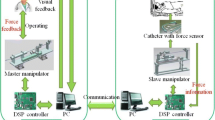Abstract
This paper presents a robotic catheter system with force sensors, monitor and a master–slave remote control system. We developed micro force sensors and applied them in the system to guarantee the operation safety in intravascular neurosurgery applications, and employed a camera to monitor the operation. Two kinds of force information are obtained through force sensors when the catheter contacted the blood vessel. The experiment shows that the proposed force sensors-based catheter system works well through force feedback and remote control. The system can facilitates the operation and avoid potential damages.












Similar content being viewed by others
References
Kanagaratnam P, Koa-Wing M, Wallace DT, Goldenberg AS, Peters NS, Wyn Davies D (2008) Experience of robotic catheter ablation in humans using a novel remotely steerable catheter sheath. J Interv Card Electrophysiol 21:19–26
Chun JK, Ernst S, Matthews S, Schmidt B, Bansch D, Boczor S et al (2007) Remote-controlled catheter ablation of accessory pathways: results from the magnetic laboratory. Eur Heart J 28(2):190–195
Pappone C, Vicedomini G, Manguso F, Gugliotta F, Mazzone P, Gulletta S, Sora N, Sala S, Marzi A, Augello G, Livolsi L, Santagostino A, Santinelli V (2006) Robotic magnetic navigation for atrial fibrillation ablation. J Am Coll Cardiol 47:1390–1400
Thakui Y, Bax JS, Holdsworth DW, Drangova M (2009) Design and performance evaluation of a remote catheter navigation system. IEEE Trans Biomed Eng 56(7):1901–1908
Arai F, Fuji R, Fukuda T (2002) New catheter driving method using linear stepping mechanism for intravascular neurosurgery. Proceedings of the 2002 IEEE International Conference on Robotics and Automation, vol 3. pp 2944–2949
Willems S, Steven D, Servatius H, Hoffmann BA, Drewitz I, Mullerleile K, Aydin MA, Wegscheider K, Salukhe TV, Meinertz T, Rostock T (2010) Persistence of pulmonary vein isolation after robotic remote-navigated ablation for atrial fibrillation and its relation to clinical outcome. J Interv Card Electrophysiol 21:1079–1084
Saliba W, Reddy VY, Wazni O, Cummings JE et al (2008) Atrial fibrillation ablation using a robotic catheter remote control system: initial human experience and long-term follow-up results. J Am Coll Cardiol 51:2407–2411
Ikeda S, Arai F, Fukuda T, Negoro M, Irie K, Takahashi I et al (2005) In vitro patient-tailored anatomaical model of cerebral artery for evaluating medical robots and systems for intravascular neurosurgery. Proceedings of IEEE/RSJ International Conference on Intelligent Robots and Systems. pp 1558–1563
Arai F, Fujimura R, Fukuda T, Negoro M (2002) New catheter driving method using linear stepping mechanism for intravascular neurosurgery. Proceedings of the 2002 IEEE International Conference on Robotics and Automation. pp 2944–2949
Tercero C, Ikeda S, Uchiyama T et al (2007) Autonomous catheter insertion system using magnetic motion capture sensor for endovascular surgery. Int J Med Robotics Comput Assist Surg 3(1):52–58
Ramcharitar S, Patterson MS, Geuns RJ et al (2008) Technology insight: magnetic navigation in coronary interventions. Nat Clin Pract Cardiovasc Med 5:148–156
Fu Y, Liu H, Wang S et al (2009) Skeleton based active catheter navigation. Int J Med Robotics Comput Assist Surg 5(2):125–135
Guo J, Xiao N, Guo S, Tamiya T (2010) Development of a force information monitoring method for a novel catheter operating system. Inf Int Interdiscip J 13(6):1999–2009
Fabrizio MD, Lee BR, Chan DY, Stoianovici D, Jarrett TW, Yang C, Kavoussi LR (2000) Effect of time delay on surgical performance during telesurgical manipulation. J Endourol 14:133–138
Wang J, Guo S, Kondo H, Guo J, Tamiya T (2008) A novel catheter operating system with force feedback for medical applications. Int J Inf Acquis 5:83–91
Acknowledgments
This research is supported by Kagawa University Characteristic Prior Research fund 2011.
Author information
Authors and Affiliations
Corresponding author
Rights and permissions
About this article
Cite this article
Xiao, N., Guo, J., Guo, S. et al. A robotic catheter system with real-time force feedback and monitor. Australas Phys Eng Sci Med 35, 283–289 (2012). https://doi.org/10.1007/s13246-012-0146-0
Received:
Accepted:
Published:
Issue Date:
DOI: https://doi.org/10.1007/s13246-012-0146-0




